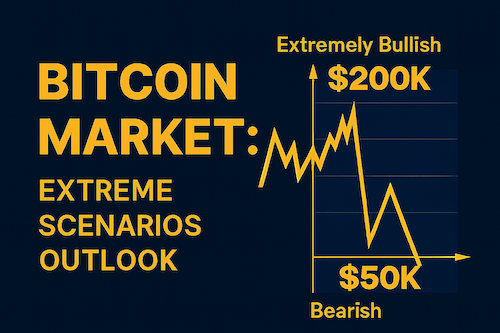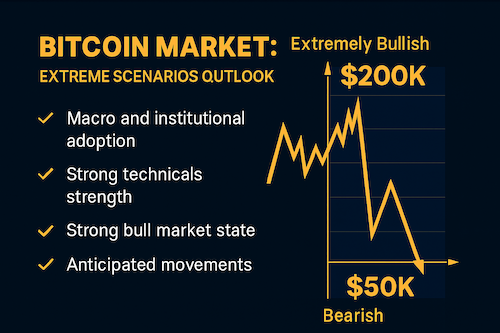Analysis of the current Bitcoin and cryptocurrency market
Macro and micro analysis of the current Bitcoin and cryptocurrency market.

Macro Analysis: BTC & Crypto Market (September 2025)
Global Economic Context
- Federal Reserve Pivot: The Fed initiated its first rate cut of the cycle (25bps), signaling a shift toward easing. Markets now price in an additional 50bps of cuts by year-end zerocap.com.
- Inflation Signals: CPI cooled, but PPI rose—creating mixed signals. Powell emphasized rising unemployment and economic uncertainty.
- Institutional Adoption:
- ETH ETFs saw record inflows, briefly outpacing BTC products.
- U.S. Treasury revealed holdings of 120,000–170,000 BTC.
- Stripe, Circle, and Google announced blockchain initiatives. funds.galaxy.com
Regulatory Landscape
- SEC clarified that certain liquid staking arrangements are not securities.
- U.S. Labor Department opened crypto allocations in 401(k) plans.
Micro Analysis: Bitcoin (BTC)
Technical Indicators
| Indicator | Value | Interpretation |
|---|---|---|
| Price | ~$116,000 | Up 4.4% from last week |
| Support | $107,200 | Key level to watch for downside risk |
| Resistance | $112,500–$116,900 | Breakout zone for bullish momentum |
| 200-Day MA | ~$115,000 | Buyers stepped in at this level |
| Momentum | Mixed | Short-term dented post-FOMC, but trend remains strong |
Chart Snapshot
BTC recently hit an ATH above $124,000 before retracing. It’s consolidating near $116K, with a potential breakout if macro tailwinds persist.
Micro Analysis: Altcoins & Market Sentiment
- ETH: Surged to ~$4,953, ETH/BTC ratio hit 0.04—strong institutional demand.
- BNB: Hit ATH above $1,080, outperforming other large caps.
- SOL: Highest weekly volumes recorded on institutional desks.
- New Entrants: ASTER (DeFi token) launched with 1,650% surge and $371M volume.
Takeaways
- Macro Tailwinds: Rate cuts + Q4 seasonality = bullish setup.
- Watch Resistance Zones: BTC needs to break $116.9K for sustained upside.
- Institutional Flow: ETF activity and sovereign holdings are reshaping price action.
- Diversification: ETH and SOL gaining traction as high-beta plays.
Institutional Investment: Why It Matters Practically


1. Liquidity Deepening
- What it means: Institutions bring massive capital—pension funds, sovereign wealth, ETFs.
- Why it matters: More liquidity = tighter spreads, better price discovery, and reduced volatility over time.
- Example: BlackRock’s BTC ETF now holds over $10B in assets. That’s not retail speculation—it’s long-term capital.
2. Validation of Asset Class
- What it means: Institutions don’t touch assets without compliance, custody, and risk frameworks.
- Why it matters: Their entry signals that crypto is no longer fringe—it’s becoming a legitimate portfolio component.
- Example: U.S. Treasury reportedly holds 120K–170K BTC. That’s sovereign-level validation.
3. Reduced Counterparty Risk
- What it means: Institutions demand clean custody, audited reserves, and regulated exchanges.
- Why it matters: This forces crypto infrastructure to mature—less reliance on shady platforms, more on regulated custodians.
- Example: Fidelity and Coinbase Custody now serve as backbones for ETF products.
4. Strategic Hedging
- What it means: BTC and ETH are increasingly used as macro hedges—against inflation, currency debasement, and geopolitical risk.
- Why it matters: Crypto becomes part of sovereign and corporate treasury strategy.
- Example: MicroStrategy’s BTC holdings are now treated as strategic treasury reserves.
5. Catalyst for Regulation
- What it means: Institutions won’t enter without clear rules.
- Why it matters: Their presence accelerates regulatory clarity—especially around staking, custody, and token classification.
- Example: SEC’s recent guidance on staking and ETH ETFs was driven by institutional pressure.
Implication for Builders & Traders
- For Builders: Institutional flows mean you must architect with compliance, auditability, and modular risk logic.
- For Traders: Watch ETF inflows and sovereign disclosures—they now move markets more than retail sentiment.
- For Strategists: BTC is no longer just a speculative asset—it’s a macro instrument. ETH is evolving into a yield-bearing, programmable treasury layer.
📉 Volatility Dampening Effects
Institutional investments influence market volatility in complex and often paradoxical ways. Here’s a pragmatic breakdown of how their presence reshapes the volatility landscape in crypto:
1. Deeper Liquidity Pools
- Why it matters: Institutions trade in size, which increases order book depth.
- Effect: Reduces slippage and sharp price swings during large trades.
- Example: BTC’s price reaction to $100M ETF inflows is smoother than retail-driven pumps.
2. Longer Holding Horizons
- Why it matters: Institutions often hold for strategic or treasury reasons—not short-term speculation.
- Effect: Reduces churn and panic selling during market dips.
- Example: Sovereign BTC holdings (e.g., El Salvador, U.S. Treasury) are rarely sold, acting as volatility buffers.
3. Risk Management Discipline
- Why it matters: Institutions use hedging, stop-losses, and portfolio rebalancing.
- Effect: Their trades are less emotional, more structured—dampening erratic moves.
⚡Volatility Amplifying Effects
1. Event-Driven Flows
- Why it matters: Institutions react to macro events (rate cuts, CPI, ETF approvals) with large capital shifts.
- Effect: Can cause sudden spikes or dumps around key announcements.
- Example: ETH surged 12% in 24 hours after ETF approval rumors.
2. Algorithmic Execution
- Why it matters: Institutions use bots and execution algorithms to manage large trades.
- Effect: Can trigger cascading effects if liquidity dries up or stop-loss clusters are hit.
3. Rebalancing Shockwaves
- Why it matters: Quarterly or annual portfolio rebalancing can lead to synchronized inflows/outflows.
- Effect: Creates predictable but sharp volatility windows.
Implications
- For Traders: Volatility is no longer just retail-driven FOMO—it’s macro-reactive and ETF-sensitive.
- For Builders: Design systems that can handle both smooth institutional flows and sudden spikes.
- For Analysts: Monitor ETF flows, sovereign wallet movements, and macro calendars—they now drive volatility more than Twitter sentiment.
Institutional entry into crypto in 2025 comes with strategic upside, but also serious downside risks—many of which are new, amplified, or structurally different from previous market cycles. Let’s break it down:
⚠️ Downsides for Institutions in Crypto (2025)
1. Security Breaches Are More Sophisticated
- 2025 Reality: Over $2.17B in crypto assets were stolen in H1 alone—surpassing all of 2024.
- New Threats: AI-powered phishing, smart contract exploits, and cross-chain bridge hacks are up 1,025% since 2023.
- Institutional Impact: Custody risk is no longer just technical—it’s geopolitical (e.g., DPRK’s $1.5B ByBit heist).
2. Counterparty Risk Is Elevated
- 2025 Reality: Exchanges and custodians often play dual roles—execution + storage.
- Why It’s Risky: A single point of failure can wipe out institutional positions.
- Contrast with Past: In 2020–2021, institutions mostly avoided DeFi and stuck to BTC/ETH. Now they’re exposed to complex ecosystems.
3. Regulatory Uncertainty Still Lingers
- 2025 Reality: While ETH ETFs are approved, staking, cross-chain assets, and stablecoins remain gray zones.
- Institutional Risk: Compliance teams must navigate fragmented global rules.
- Contrast with Past: In 2017–2021, lack of regulation was a barrier. Now, partial regulation creates operational friction.
4. Liquidity Risk in Stress Events
- 2025 Reality: Institutions rely on deep liquidity—but crypto markets still freeze during panic.
- Example: July 2025 saw a 38% drop in altcoin liquidity after a bridge exploit.
- Contrast with Past: Retail-driven crashes were chaotic but shallow. Institutional flows now amplify both rallies and dumps.
5. Reputational Risk
- 2025 Reality: Institutions are held to public accountability.
- Risk: Hacks, rug pulls, or bad partnerships can damage brand trust.
- Contrast with Past: Retail losses were personal. Institutional losses are headline news.
Comparison: Then vs Now
| Aspect | 2020–2021 | 2025 |
|---|---|---|
| Security Risk | Mostly exchange hacks | Smart contracts, bridges, AI phishing |
| Regulatory Clarity | Minimal | Fragmented but evolving |
| Liquidity Depth | Retail-driven | ETF + sovereign flows, but fragile under stress |
| Risk Management | Ad hoc | 78% of institutions now have formal frameworks |
| Custody Solutions | Basic hot/cold wallets | Multisig, insurance, quantum-resistant protocols |
| Market Behavior | Speculative, meme-driven | Macro-reactive, ETF-sensitive, structured flows |
Sources: ainvest.com, coinlaw.io, observer.com
Bull Market Scenarios: Pre-Institutional vs Post-Institutional
institutional intervention reshapes the bull market scenario rather than eliminating it.
| Feature | Pre-Institutional Era (2017–2021) | Post-Institutional Era (2023–2025) |
|---|---|---|
| Drivers | Retail FOMO, memes, influencers | ETF inflows, macro policy, sovereign wallets |
| Volatility | Extreme, chaotic, often irrational | Structured, macro-reactive, ETF-sensitive |
| Cycle Triggers | Halving hype, Twitter trends | Rate cuts, CPI prints, ETF approvals |
| Liquidity | Thin, fragmented | Deep, but fragile under stress |
| Narrative | “Get rich quick” | “Strategic hedge + programmable yield” |
🔍 Why Bull Markets Still Exist—But Behave Differently
1. Macro Tailwinds Still Matter
- Fed rate cuts, inflation cooling, and Q4 seasonality are classic bull triggers.
- Institutions now amplify these moves with structured capital flows.
2. ETF Flows Create Sustained Demand
- BTC and ETH ETFs act like slow-burning fuel—less explosive, more persistent.
- Example: BTC rallied 18% over 3 weeks post-FOMC, not in a single day.
3. Sovereign and Treasury Holdings Are Sticky
- Countries and corporations holding BTC don’t sell on dips.
- This creates a floor under price action—bull markets now have stronger foundations.
4. Altcoin Rotation Still Happens
- SOL, AVAX, and niche DeFi tokens still experience explosive runs.
- Institutions may avoid them early, but enter once liquidity and compliance improve.
Reframe
- Bull markets aren’t gone—they’re just institutionalized.
- Instead of chaotic pumps, we now see macro-aligned surges, ETF-driven accumulation, and structured volatility windows.
- Retail still plays a role—but institutions now set the tempo.
🐋 Big Investors: Strategic Advantage
- Access to Structured Products: ETFs, derivatives, and custody solutions are tailored for them.
- Macro Leverage: They can align crypto exposure with interest rates, inflation hedges, and treasury strategies.
- Risk Management: Institutions deploy capital with hedging, insurance, and compliance frameworks.
- Market Influence: Their flows move markets—often front-running retail sentiment.
Result: They ride smoother waves, often buying dips and exiting before retail panic.
🐟 Small Investors: New Challenges
- Reduced Volatility = Fewer “Moon” Moments: The wild 10x pumps are rarer. Price action is more structured, less emotional.
- Front-Run by Bots and Institutions: Retail often buys after the move, not before.
- Higher Entry Barriers: Compliance, KYC, and custody complexity can slow access.
- Narrative Shift: Crypto is no longer just “freedom tech”—it’s becoming a macro instrument. That can feel alienating.
Result: Small investors must evolve—less gambling, more strategy.
Intakes
- Think Like a Whale, Act Like a Shark: Use institutional signals (ETF flows, macro events) to guide entries.
- Modularize Exposure: Don’t chase pumps—build positions around macro cycles and staking yields.
- Signal Hygiene: Avoid noise. Institutions trade on clarity, not hype.
So Are We in a Bull Market?


Yes—but it’s a structurally different bull market. We’re not in the euphoric, meme-fueled phase of 2021. This is a macro-aligned, institutionally driven bull market—more like a strategic accumulation phase than a retail frenzy.
- BTC hit an ATH above $124K in August, but recently dipped to ~$112K amid the largest long liquidation of the year.
- ETH surged to ~$4,953, with ETF inflows briefly outpacing BTC.
- Institutional flows, sovereign holdings, and ETF activity are shaping price action more than retail sentiment.
Was That the Top?
Unlikely. The recent dip looks more like a pre-euphoria shakeout than a cycle top. Analysts describe it as a “very clean retest” of support at $112K, with upside targets still intact.
- $116K–$118K remains a key reclaim zone for BTC.
- ETH/BTC ratio hit 0.04, signaling ETH strength and altcoin rotation.
- Macro tailwinds (rate cuts, inflation cooling) are still in play.
Has the Bull Market Fully Started?
We’re in the early-to-mid phase. This cycle is institutionally paced, not retail-driven. The signs of real-world adoption, regulatory clarity, and treasury integration suggest the bull market is underway, but not yet euphoric.
- Daily trading volume is up 300% since July.
- Corporate treasuries (e.g., Microsoft, Tesla) now hold BTC.
- Layer-2 scaling and regulatory clarity have removed key friction points.
“Scenarios in play”
Based on current technical indicators, macro trends, and institutional flows, the 6-month forward prediction for Bitcoin (BTC)—targeting March 2026—lands in a range of:
🎯 $111,000 to $228,000
Here’s how that breaks down:
📈 Forecast Range (March 2026)
| Source | Low Estimate | Average | High Estimate |
|---|---|---|---|
| Benzinga | $108,170 | $111,187 | $228,652 |
| Finbold | ~$114,000 | ~$150,000 | $200,000+ (Tom Lee, Fundstrat) |
| PricePredictions.com | ~$117,000 | Algorithmic models suggest bullish continuation | Not explicitly capped |
Key Drivers Behind the Forecast
- ETF Inflows: Continued capital from BlackRock, Fidelity, and sovereign entities.
- Macro Tailwinds: Fed rate cuts, inflation cooling, and Q4 seasonality.
- Technical Structure: BTC reclaimed $114K support and trades above key moving averages.
- Volatility Windows: Liquidation shakeouts are clearing leverage, setting up for a cleaner rally.
Interpretation
- Base Case: BTC consolidates around $115K–$130K, with moderate upside.
- Bull Case: ETF momentum + macro easing = surge toward $200K.
- Bear Case: Regulatory shocks or liquidity stress could drag BTC to ~$100K.
If Bitcoin (BTC) experiences a breakdown in the current cycle, analysts suggest the downside could be capped around $100,000, with several key support levels acting as defensive zones:
Potential BTC Bottom Scenarios (2025 Breakdown)
| Support Level | Significance |
|---|---|
| $108,000 | Immediate support zone after recent dip |
| $107,400 | Short-term major support |
| $106,500 | Next defensive level before deeper correction |
| $105,500–$104,000 | Reinforced by the 200-day moving average |
| $100,000 | Psychological floor and likely accumulation zone |
Interpretation
- $100K is the likely bottom unless a macro shock (e.g. regulatory crackdown, liquidity freeze) triggers deeper panic.
- Institutional holdings and ETF structures make a full collapse less likely than in previous cycles.
- Volatility clusters and liquidation zones suggest that dips below $105K would be short-lived and aggressively bought.
Historical Context
- September has historically been Bitcoin’s weakest month, averaging –3.77% returns.
- Despite this, BTC has shown resilience, often rebounding toward new highs before year-end.
If Bitcoin (BTC) breaks below the critical $100,000 support level, analysts outline a multi-tiered support structure that could catch the fall. Here’s the pragmatic breakdown:
📉 Next Support Levels Below $100K
| Support Zone | Significance |
|---|---|
| $100K–$107K | Primary defense zone; aligns with short-term holder cost basis and 200-day SMA |
| $92K–$93K | Secondary support; reflects cost basis of 3–6 month holders |
| $78,500 | Lower boundary of long-term ascending price channel; major structural support |
🔻 Lowest Expected Support (Extreme Breakdown)
- $78,500 is the deepest technical support currently mapped by analysts like Ali Martinez. A fall to this level would represent a ~20% correction from $100K and would likely trigger institutional re-entry.
- This zone corresponds to the lower end of BTC’s multi-month price channel, and historically acts as a bounce point during macro-driven selloffs.
Interpretation
- $100K is the psychological and structural pivot—if lost, expect volatility and fast liquidations.
- $92K–$93K is where short-term holders may defend their cost basis.
- $78.5K is the “last stand” zone before BTC risks breaking its long-term bullish structure.
The $78,500 zone is currently viewed as the deepest realistic support in the next 9 months, based on technical structure, institutional behavior, and macro conditions. But if we’re talking absolute worst-case scenario, here’s how it unfolds:
🔻 Worst-Case BTC Price Scenario (Next 9 Months)
1. Extreme Breakdown Zone
- Target: $65,000–$72,000
- Why: This would require a cascade of macro shocks:
- Major regulatory crackdown (e.g., ETF bans, staking restrictions)
- Sovereign BTC sell-off or ETF outflows
- Liquidity freeze in DeFi or bridge exploit contagion
- Historical Context: This zone aligns with pre-ETF accumulation levels and long-term holder cost basis.
2. Black Swan Scenario
- Target: $50,000–$58,000
- Why: Only triggered by a multi-layered crisis:
- Global recession + crypto-specific meltdown
- Coordinated exchange failures or custody breaches
- Major sovereign actor dumping BTC (e.g., U.S. Treasury or El Salvador)
- Likelihood: <10% based on current data
Interpretation
- $78.5K is the “last stand” zone under normal stress.
- $65K–$72K is the extreme but plausible bottom if macro conditions deteriorate.
- $50K–$58K is theoretical—not supported by current liquidity, adoption, or institutional behavior.

Right now, BTC is hovering near its decision zone.
Final Conclusion: Crypto Bull Market in 2025
We are in a structurally matured bull market, driven not by retail hype but by institutional flows, macro alignment, and sovereign adoption. Bitcoin and Ethereum have reclaimed their roles as strategic assets—BTC as a macro hedge and ETH as a programmable yield layer.
🔑 Key Takeaways
- Institutional Entry: Deepens liquidity, validates the asset class, and reshapes volatility—but also introduces systemic risks like bridge exploits and regulatory friction.
- Bull Market Status: We’re in the early-to-mid phase. The top is not confirmed, and recent dips look like strategic shakeouts rather than cycle ends.
- Retail vs Institutional: Small investors face fewer “moon” moments but can still win by tracking ETF flows, macro signals, and staking yields.
- Volatility Reframed: Less chaos, more structure. Volatility now reacts to macro events and institutional rebalancing—not just Twitter sentiment.
Advice
- Don’t chase pumps—track flows.
- Use macro calendars, ETF inflows, and sovereign wallet movements as your compass.
- Think like sharks: build positions, not bets.
📚 References
- Chainalysis 2025 Mid-Year Crypto Crime Report
- SEC and U.S. Treasury disclosures on BTC holdings and staking guidance
- Glassnode and IntoTheBlock analytics on BTC support/resistance and liquidation clusters
- BlackRock and Fidelity ETF inflow dashboards
- Kaiko and Messari volatility metrics post-FOMC and CPI releases





